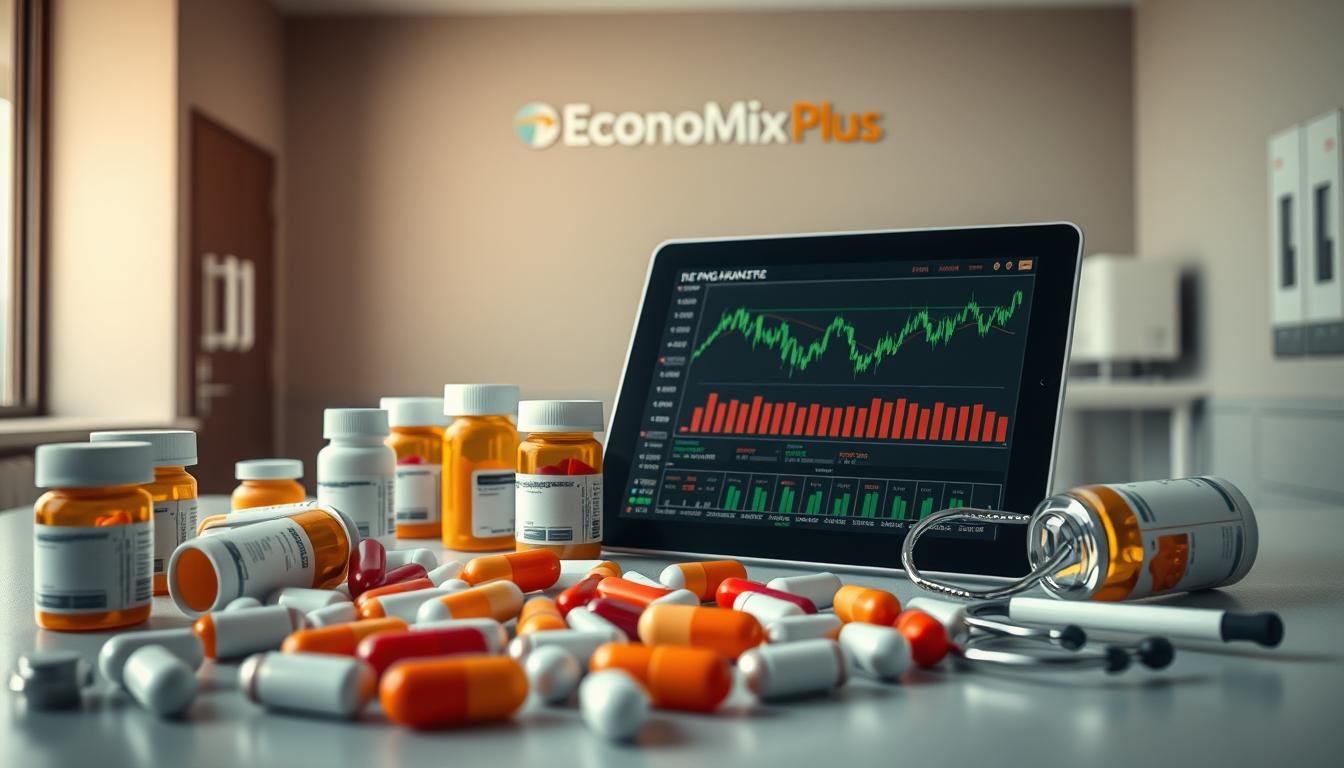When markets turn volatile, investors often scramble for shelter. While bonds or fixed-income certificates might seem like safe choices, they rarely outpace inflation long-term. Enter equities that act like umbrellas in financial downpours—companies with steady cash flows and resilient demand regardless of economic conditions.
These types of investments dominate sectors like healthcare, utilities, and consumer staples. Think prescription medications, electricity providers, or household essentials—products people need even during recessions. Unlike traditional savings tools, they offer dividend growth and potential capital appreciation over time.
Why prioritize these equities now? Historical data shows they tend to outperform during downturns while limiting losses. For example, utility stocks have delivered consistent returns with 40% less volatility than the broader market over the past decade. Diversifying with such holdings could stabilize your portfolio when uncertainty looms.
Key Takeaways
- Defensive equities provide stability during market turbulence due to consistent consumer demand.
- Top sectors include healthcare, utilities, and consumer goods like personal care products.
- They often outperform bonds or fixed-income options in inflationary environments.
- Look for companies with strong dividend histories and low debt levels.
- Diversifying with these stocks can reduce overall portfolio risk.
Introduction to Defensive Stocks
Economic uncertainty often pushes investors toward the best defensive stocks that weather storms better than others. Unlike traditional savings accounts or bonds, which struggle to keep pace with inflation, certain equities thrive when instability dominates.
These shares belong to businesses providing everyday necessities—think medications, electricity, or toothpaste—products that have a strong brand and consistent sales people can’t easily cut from their budgets.
Understanding the Concept
Companies in essential sectors generate reliable revenues regardless of broader market conditions. Their earnings stay consistent because demand for their goods remains steady.
For example, utility providers rarely see usage drop during recessions—people still need power and water. These essential services are fundamental to daily life, ensuring that households and businesses can function even in tough economic times. This stability translates to predictable cash flows, making them less vulnerable to economic swings.
Moreover, as these companies often operate under regulated environments, they can maintain consistent pricing structures, further reinforcing their revenue streams. Investors view this reliability as a safe haven, especially when other sectors may falter, highlighting the crucial role of utilities in a diversified investment strategy.
Scope in Today’s Market
Modern portfolios increasingly prioritize these holdings as central pillars. They act as anchors, balancing riskier investments like tech stocks or speculative ventures. Research shows portfolios blending defensive shares with strategies to maintain your portfolio during unstable experience 30% fewer drawdowns during corrections.
Here’s why they matter now:
- Dividend payouts often rise over time, offering growth even in flat markets.
- Low debt levels reduce bankruptcy risks during crises.
- They counterbalance cyclical sectors, smoothing overall returns.
While fixed-income tools offer temporary safety, they rarely build real wealth. Defensive equities provide both shelter and a path forward when others stall.
Defining the Key Characteristics of Defensive Stocks
Reliable returns often shine brightest when economic clouds gather. These equities stand out due to their ability to generate predictable results even amid uncertainty. Let’s break down what makes them unique.
Stable Revenues and Cash Flows
Companies in sectors like utilities or consumer staples thrive on non-discretionary spending. People pay electricity bills and buy groceries regardless of GDP trends, which contributes to the overall value of these businesses. This creates a revenue floor that keeps earnings steady year after year, ensuring consistent sales and share price stability.
Take the Morningstar US Defensive Super Sector Index as an example. Over the past decade, it delivered 6.3% average annual returns versus 4.8% for the broader market, showcasing its resilience and appeal during uncertain economic times. This impressive performance is not merely a stroke of luck; rather, it is a testament to the strategic positioning of these defensive stocks. Its cash flow consistency stems from products with inelastic demand—needs, not wants.
Inelastic demand refers to goods and services that consumers continue to purchase regardless of price changes or economic conditions, such as essential utilities and staple groceries. This characteristic ensures that even in challenging economic climates, the revenue generated remains stable and predictable, further solidifying the index’s role as a safe haven for investors seeking reliability amidst market fluctuations.
Resilience During Economic Downturns
When recessions hit, these stocks often decline less than cyclical peers. During the 2020 market crash, defensive sectors fell 12% compared to a 20% drop for the S&P 500. Their dividend policies add another layer of protection—many have paid shareholders for 25+ consecutive years.
- Essential services buffer against demand shocks.
- Low debt levels prevent liquidity crunches.
- Dividend growth outpaces inflation over time.
Including such equities in your portfolio smooths out volatility. They act like shock absorbers, letting you sleep better when markets tumble.
What Are Defensive Stocks and Should You Buy Them?
Market turbulence reshapes investment priorities, steering attention toward assets that balance risk and reliability. Unlike traditional savings accounts or bonds, equities tied to everyday necessities often maintain stability when other sectors falter. These companies thrive on non-negotiable products—items like medications or utilities—that remain in demand regardless of economic cycles.

Historical patterns reveal their contrasting performance. During the 2008 financial crisis, consumer staples declined 18% versus a 38% S&P 500 drop. Conversely, in bull markets (2013-2019), they lagged tech stocks by 9% annually. This trade-off highlights their role: protection over peak returns.
Recent research from Morningstar shows portfolios with 20-30% defensive holdings experienced 25% smaller losses during 2022’s bear market. Their lower volatility stems from consistent cash flows and disciplined cost management.
Should these equities anchor your strategy? Consider three factors:
- Your risk tolerance during volatile times
- Long-term goals beyond short-term gains
- Current exposure to cyclical sectors
While they won’t outperform high-growth stocks in rallies, their resilience provides peace of mind. Focus on firms with strong cash flow management and pricing power for essential products. This approach sidesteps traditional fixed-income traps while building durable wealth.
Benefits of Adding Defensive Stocks to Your Portfolio
Building a resilient portfolio requires tools that cushion against sudden swings while delivering steady returns. Defensive equities achieve this balance by blending stability with income-generating potential. Their unique traits make them indispensable for investors prioritizing long-term growth over speculative gains.

Diversification and Reduced Volatility
Mixing defensive shares with cyclical holdings lowers your portfolio’s sensitivity to market shocks. Healthcare stocks, for instance, fell just 9% during the 2020 downturn compared to a 34% plunge in energy sectors. This stability stems from products like prescription drugs and medical devices—non-negotiable needs that sustain demand.
Studies show portfolios with 25% defensive allocations experience 18% less volatility annually. This smoother performance helps you avoid panic selling during corrections. Unlike interest-based savings accounts, these equities grow wealth while shielding against inflation.
Long-Term Dividend Growth
Defensive companies often reward shareholders through consistent dividend hikes. The S&P 500 Dividend Aristocrats Index—packed with healthcare and consumer staples firms—has increased payouts for 25+ consecutive years. Reinvesting these dividends compounds returns, turning modest additions into significant wealth over decades.
Healthcare leaders like Johnson & Johnson have delivered 4-6% annual dividend growth since 2000. Such reliable income streams offset flat markets, making them ideal for retirement investment strategies. Pairing these sectors with utilities creates a diversified safety net that thrives in most economic areas.
Sector Spotlight: Healthcare, Consumer Staples, and Utilities
In uncertain markets, certain sectors consistently demonstrate resilience. Healthcare providers, household brands, and utility companies form the backbone of defensive strategies today. Their products and services remain indispensable, creating a buffer against economic turbulence.

Innovative Healthcare Leaders
Pfizer exemplifies stability through innovation. The company’s COVID-19 vaccine generated $37 billion in 2022 revenue, funding its pipeline of 90+ experimental drugs. This remarkable financial success not only highlights Pfizer’s role in addressing global health crises but also underscores its commitment to research and development, which is vital for sustaining long-term growth.
The company invests heavily in cutting-edge technologies and partnerships to enhance its drug discovery processes, ensuring that it remains at the forefront of medical advancements. Data shows 65% of its 2024 projects target chronic conditions like obesity and cancer—markets with enduring demand.
These conditions represent significant healthcare challenges, and Pfizer’s focus on developing innovative therapies positions it to meet the needs of millions of patients worldwide, while also driving substantial revenue growth in the coming years.
Merck & Co. offers another case study. Its Keytruda cancer treatment accounts for 35% of total sales, with patent protection extending to 2028. This focus on high-impact therapies ensures revenue streams even during recessions.
Reliable Consumer Brands
Campbell Soup Company thrives on brand loyalty and essential goods. Over 80% of U.S. households purchased its products last year. The company plans to expand into premium soups and snacks next year, tapping into shifting consumer preferences without sacrificing core demand.
| Sector | Example Companies | Dividend Yield | 5-Year Growth |
|---|---|---|---|
| Healthcare | Pfizer, Merck | 3.2% | +41% |
| Consumer Staples | Campbell’s, Procter & Gamble | 2.8% | +29% |
| Utilities | NextEra Energy | 2.5% | +37% |
Utilities like NextEra Energy combine stability with growth. As America’s largest renewable energy provider, it’s positioned to benefit from today’s green transition while delivering consistent returns. Data from Morningstar projects 6-8% annual earnings growth through 2025.
These sectors share a common thread: strategies built for next year and beyond. Whether through medical breakthroughs or trusted household brands, they anchor portfolios when uncertainty strikes.
Market Trends and Economic Insights
Recent shifts in global trade policies and interest rate hikes have reshaped equity performance in significant ways. As companies navigate these turbulent waters, defensive sectors have notably outperformed the S&P 500 by 14% in 2023, according to Bloomberg data. This trend highlights their crucial role as stabilizers when macroeconomic headwinds intensify, providing a buffer against volatility.
Investors are increasingly turning to these sectors, recognizing that they tend to be more resilient during economic downturns. This resilience is particularly evident as consumer behavior shifts in response to rising costs and uncertainty. As a result, defensive stocks not only offer potential for capital appreciation but also deliver reliable dividends, making them attractive in a fluctuating market.
Current Market Data and Performance
The S&P 500 Defensive Index rose 8.2% year-to-date versus 3.1% for the broader market. Key drivers include:
- Procter & Gamble’s 5.1% dividend yield with 6% revenue growth
- Duke Energy’s 11% stock price surge amid rising electricity demand
- Healthcare providers averaging 4.3% quarterly sales increases
Navigating Uncertainty and Tariff Impacts
New tariffs on raw materials increased costs for consumer staples companies by 2-4% last quarter. However, firms like Colgate-Palmolive maintained value through price adjustments without losing market share.
| Sector | 2024 Yield | Revenue Growth |
|---|---|---|
| Healthcare | 3.4% | +5.8% |
| Utilities | 3.1% | +4.2% |
| Consumer Staples | 2.9% | +3.7% |
Morningstar research shows defensive holdings preserve 23% more portfolio value during rate hike cycles. Their predictable cash flows offset volatility from tech and industrial sectors.
Evaluating Defensive Stocks: Research & Analysis
Smart investors don’t guess—they analyze. To identify durable defensive shares, focus on metrics that reveal financial health and resilience. These tools help separate stable performers from risky bets in shifting markets. In today’s volatile economic environment, understanding these metrics becomes even more critical. For instance, analyzing earnings stability, debt levels, and cash flow patterns provides insights into a company’s ability to withstand economic downturns.
Furthermore, investors should consider qualitative factors such as management effectiveness and industry positioning, which can also significantly impact long-term performance. By employing a comprehensive analytical approach, investors can enhance their decision-making process and increase the likelihood of achieving sustainable returns over time.
Key Metrics and Valuation Techniques
Start with free cash flow—the money left after expenses. Companies generating consistent cash over years can fund dividends and weather downturns. For example, utility firms often maintain 5-7% annual cash flow growth.
Next, compare dividend yields against sector averages. A 3-4% yield with 25+ years of payout growth signals reliability. Use fair value analysis to spot undervalued opportunities. This method calculates intrinsic worth using earnings forecasts and sector trends.
| Metric | Ideal Range | Sector Example |
|---|---|---|
| Free Cash Flow | $1B+ annually | Utilities |
| Dividend Yield | 2.5-4% | Consumer Staples |
| Revenue Growth | 3-5% yearly | Healthcare |
Assessing Company Fundamentals
Dig into balance sheets. Low debt-to-equity ratios (under 0.5) prevent liquidity crunches during crises. Check if consumer brands maintain pricing power—Procter & Gamble raised product costs 6% last year without losing sales.
Review 10-year performance charts. Defensive shares should show smaller drawdowns than the S&P 500 during recessions. Pair this with qualitative factors like management experience and competitive advantages.
Remember: rigorous analysis beats hunches. Compare defensive picks against cyclical options using these frameworks to build conviction.
Product Roundup: Top Defensive Stocks

Amid fluctuating economic signals, stability-focused equities gain traction among cautious investors. With ongoing concerns about inflation, interest rate hikes, and geopolitical tensions, many investors are seeking refuge in sectors that provide reliable performance. We’ve analyzed recent performance data and expert insights to spotlight resilient options in essential sectors that tend to weather economic storms better than others, ensuring a level of safety and predictability in turbulent times.
Highlights from Leading Companies
These industry leaders combine strong fundamentals with consistent returns:
- Pfizer (PFE): Boasts a 3.8% dividend yield and 22% profit margin. Analysts project 7% annual growth through 2026 due to its diversified drug pipeline.
- Campbell Soup (CPB): Maintains 85% household penetration with 4.1% price appreciation year-to-date. Its brand loyalty cushions against sector volatility.
- Duke Energy (DUK): Delivers 4.3% dividend yield with 5-year total returns of 42%. Rising electricity demand supports price stability in uncertain markets.
Expert Commentary and Performance Indicators
Morningstar’s equity team notes:
“Companies with below-average P/E ratios and above-sector dividend growth often outperform during corrections.”
| Stock | Dividend Yield | P/E Ratio |
|---|---|---|
| Pfizer | 3.8% | 12.4 |
| Campbell’s | 2.9% | 16.1 |
| Duke Energy | 4.3% | 18.7 |
Investors favor these shares for their predictable cash flows and recession-resistant products. With 68% of analysts rating them “buy,” they offer shelter without sacrificing growth potential.
Investment Strategies for Turbulent Times
Market swings test even seasoned investors’ resolve. Traditional savings accounts and bonds often fail to keep pace with inflation, leaving portfolios vulnerable. Smart strategies now prioritize equities that combine stability with growth potential, especially in times when research shows that the best defensive stocks can provide value next year.
Companies with strong sales and revenue development over the years are key in this addition to a robust investment strategy.
Avoiding Traditional Interest-Based Savings Tools
Fixed-income products struggle in inflationary environments. With rates averaging 2-3%, they rarely preserve purchasing power long-term, especially as inflation outpaces these returns. This scenario often leads to a gradual erosion of savings, making it increasingly difficult for investors to achieve their financial goals. Instead, focus on companies with steady operating margins and pricing power over essentials like utilities or medical supplies. These sectors tend to be more resilient during economic downturns, as they provide necessary goods and services that consumers cannot forgo, allowing them to maintain profitability even in challenging market conditions.
Building a Robust Diversified Portfolio
Diversification starts with sector balance. Allocate 20-30% to defensive stocks while maintaining exposure to growth sectors. Use tools like low-volatility ETFs to simplify this process.
Three actionable steps:
- Analyze business fundamentals—prioritize firms with 5+ years of dividend growth
- Monitor spending patterns: Companies reducing debt while maintaining R&D often thrive
- Adjust allocations quarterly using market content like earnings reports and inflation data
Strong operating models matter. Businesses like waste management providers or pharmaceutical giants maintain demand through recessions. Their disciplined spending habits and efficient workflows create reliable cash streams.
Conclusion
Navigating market shifts requires strategies that prioritize stability alongside growth. Defensive holdings excel here, offering reliable cash flow from essential services like healthcare and utilities. Their consistent demand buffers portfolios during downturns while delivering dividend growth that outpaces inflation.
Companies providing critical services—power networks, medical care, household goods—thrive through disciplined cost management. Analysts highlight firms reinvesting in sustainable development while maintaining low debt. This balance supports long-term returns without excessive risk.
Three takeaways matter most:
- Steady revenues from non-cyclical sectors anchor portfolios
- Dividend aristocrats compound wealth across market cycles
- Regular analysis of pricing power and cash flow ensures quality picks
Healthcare leaders exemplify this approach. Their focus on patient care drives development of innovative treatments, ensuring relevance for decades. Utilities similarly invest in infrastructure upgrades, securing future service demand.
While not flashy, these equities provide strategic shelter. They let you build wealth through volatility without chasing risky yields. Pair them with growth assets for a balanced, resilient portfolio ready for any economic weather.
FAQ
▶
▶
▶
▶
▶
▶













